Podcast 6
Ask the Builder Podcast 6 Highlights:
- Sarah and Tom's window is melting a neighbors vinyl siding!
- Steve's glass block window in his shower is leaking. Tim has a simple and fast solution.
- Pam has mystery salt deposits forming on her California garage floor. Why?
- Tim shares a story about what happens when gasoline is not used properly. - NOTE: Transcript of this story below.
Podcast Sponsor: Stain Solver - Certified Organic Oxygen Bleach
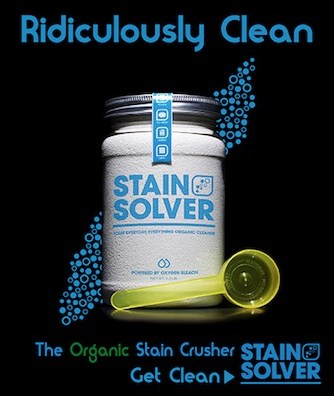
Stain Solver is MADE in the USA with USA ingredients that are food-grade quality. CLICK THE IMAGE to order some NOW.
Home Improvement and Home Construction Podcast
Photos, Links and Great Stuff:
CALL 1 Sara & Tom's Death Ray Window Melts Siding:
Related Links:
Skyscraper Glass Sets Cars and Buildings On FIRE!
Concave Window Glass Warps and Melts Vinyl Siding
Vinyl Siding Institute's Position Statement on Melted Siding
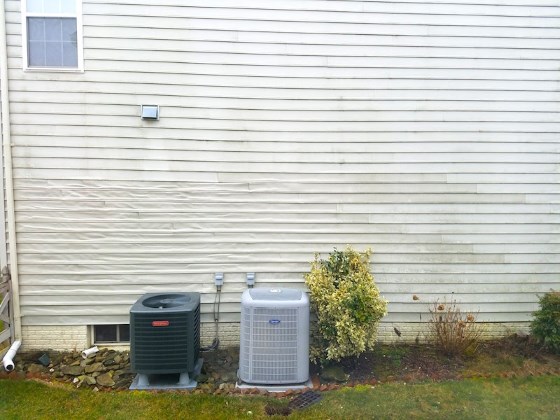
Here's the neighbor's melted vinyl siding caused by the death-ray windows on Sarah & Bob's house. In all seriousness, the blame for the problem could be shared. Vinyl siding that can withstand higher temperatures is available. Copyright 2018 Tim Carter
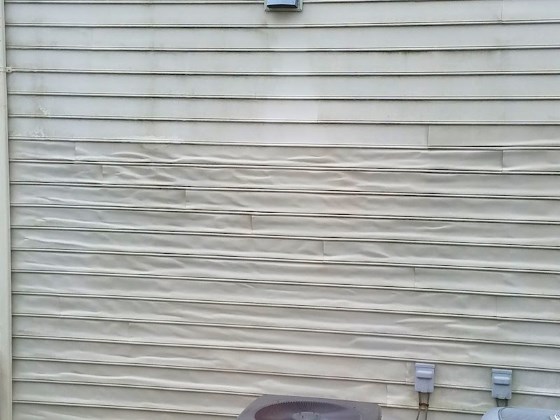
Here's a close-up shot of the melted and warped siding. Copyright 2018 Tim Carter
Call 2 - Steve's Leaking Shower Glass Block Window
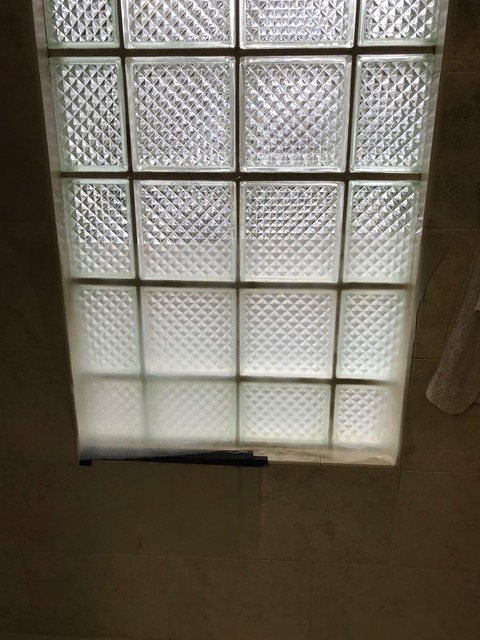
This is the source of Steve's woes. The surface of the glass block should have been flush with the tile. Copyright 2018 Tim Carter
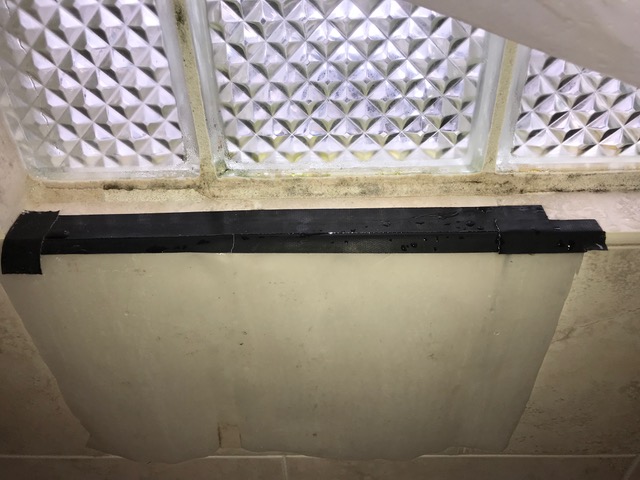
No amount of grout or caulk will solve the leak. Copyright 2018 Tim Carter
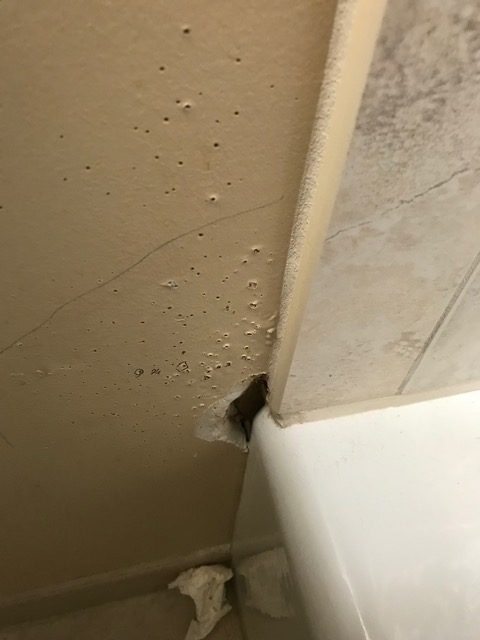
The small holes are from the moisture meter probes. The big hole is where Steve inserted paper towels to test for the leak. Copyright 2018 Tim Carter
Related Links:
Glass Block Cool Install Video
Plastic and Glass Blocks - Large Ideas at a Reasonable Price
Call 3: Pam's Mystery Salt Deposits on Garage Floor

Here's Pam's garage floor. Look at the mystery deposits. Copyright 2018 Tim Carter
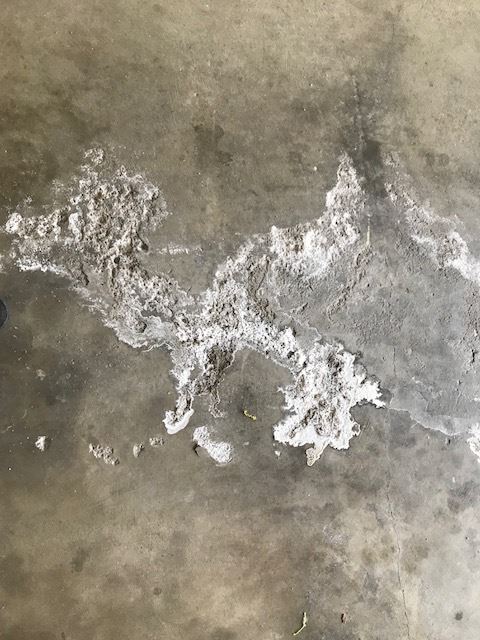
This is a close up of Pam's efflorescence. It's directly related, in my opinion, to the salt water in the air around her home. Copyright 2018 Tim Carter
Efflorescence Related Links:
Does Efflorescence Damage Concrete? Interesting Answer!
Tim and the Flaming Monster Story
Let’s travel back in time to when I was a young pup builder. I’ve got a sobering tale for you that could save your life or that of a loved one. At the very least it might save a dreadful trip to an emergency room with subsequent hospital visits for reconstructive surgery.
If you asked me to title this story I think I’d call it - Beware of the Invisible Creeping Vapors
As you proceed down the path of being a builder you collect things. Experience is one. Friends are another. You also gather up vast amounts of knowledge.
On a warm sunny day in southeast Indiana I got a wheelbarrow full of knowhow about what NOT to do when getting rid of scrap lumber.
That summer found me framing a house for my drywall contractor. He and his wife had purchased a lot at a large community centered around a man-made lake.
I don’t remember much about the house other than it was built on a slight grade and the backyard sloped down and away from the house.
The excavator had cleared all the trees away from the construction area leaving a bare dirt perimeter of at least 30 feet. When it rained, the clay soil would transform into a quagmire of sticky goo that stuck to everything.
Some house plans are so efficient that when you build them you end up with minimal scrap wood. I was the lead builder on the second Habitat for Humanity house in Cincinnati, Ohio. The stock plan supplied by the national Habitat for Humanity headquarters was so well thought out that all we had at the end of the job were small scraps of wood that fit into ONE garbage can. I’m serious - one garbage can.
This was not the case with my drywall finisher’s home. His plan generated LOTS of waste scrap framing lumber and plywood.
It’s important to realize my drywall finisher was frugal. I’ll go as far to say he was a penny pincher. He didn’t want to pay for a construction dumpster to cart away all the construction debris.
One day he stopped by and said to me, “Tim, could you just put all the crap out back and set it on fire? I got permission from the local fire department to have a bonfire.”
I didn’t challenge him about the permission statement as I felt that was probably a stretch. I also didn’t think about who would eventually get the blame if there was a problem. No doubt the person who struct the match, NOT the property owner!
We put all the scrap lumber out back as far away from the house as possible. It was randomly stacked so lots of air could get into the pile.
I remember waiting for a day when the wind was blowing away from the house before we set the wood on fire. Looking back it was an idiotic thing to have a fire even 30 feet away from a tinder-dry frame house with no windows in place, open walls and exposed wood everywhere. It wouldn’t take much to set the entire house on fire.
I used air-powered nail guns to frame houses back then. The compressed air was created by a small gasoline engine connected to an air compressor. I always had two or three gallons of gasoline on my truck to feed the noisy beast that belched air.
One of my helpers doused the pile with some gasoline to get the fire going. That was mistake number one. It wasn’t needed. All we had to do was light a little bit of cardboard at the base of the pile and that would have got the fire going just fine.
I was standing upwind of the pile about twenty feet but I was also downhill from the fire pile. My helper wanted to be the one to throw the match on the pile. I think he was a pyromaniac now that I recall this day.
Him striking the match and throwing it onto the pile is still clear in my head. I can still recall the tiny torch floating through the air and landing on the wood.
The next thing I remember was a giant WHOOSH as the gasoline ignited. A giant mushroom cloud of flame leapt up to the sky. However, I wasn’t prepared for the large tongue of flame shooting across the soil that came straight at me. It was a monster amount of fire.
I guess I didn’t pay attention in chemistry class in high school and forgot that gasoline fumes and vapors are HEAVIER than air. The fumes were flowing down the hill towards me like a water stream flows in between two mountains.
Fortunately I jumped in time to avoid the blowtorch. I didn’t get hurt, but it was far too close for comfort. Newspapers and websites are littered with stories about people getting seriously burned in similar situations when invisible gasoline, paint thinner, lacquer thinner fumes ignite in garages, basements, or outdoors.
Be very careful when working with combustible liquids. Understand that the fumes are creeping about you, surrounding you and moving away from you to low spots.
Never forget - Do It Right, Not Over!
Subscribe to the AsktheBuilder Podcast
 |
 |
|
| . | ||
 |
 |
